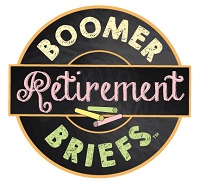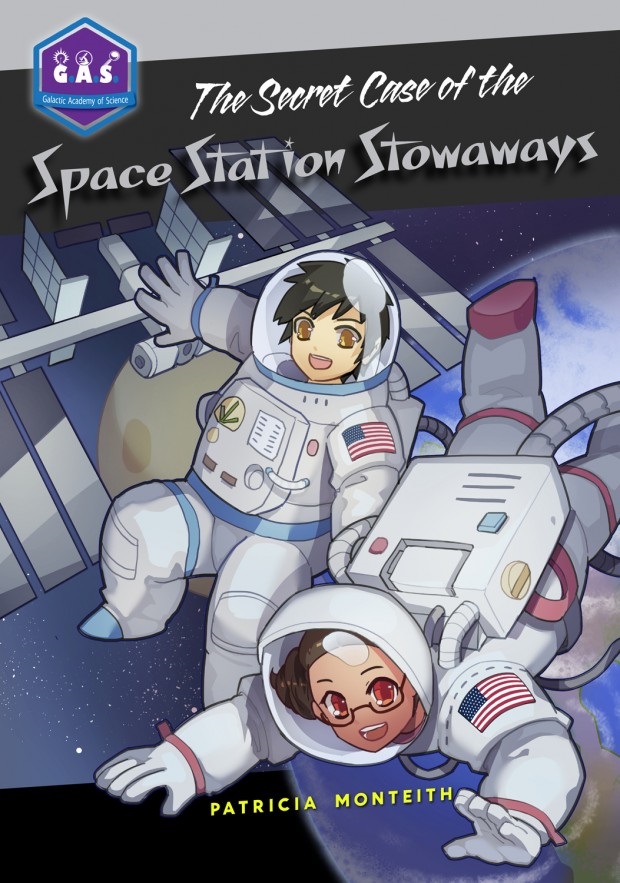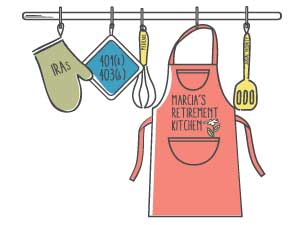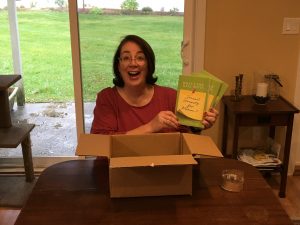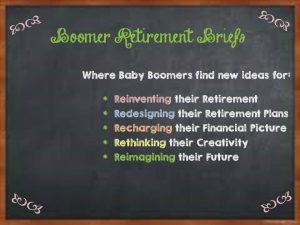
“I get bored easily,” Pat declared. Those were her opening words during our recent conversation about her volunteering in retirement. Pat is an incredible woman I met at Altrusa, a women’s volunteer organization that focuses on literacy. At one of our meetings, she commented that she was really tired. When asked why, she said she was busier now in retirement than when she was working. What was taking up so much of this retiree’s time?
Volunteering in retirement is many Boomer’s goal
For the past decade, I’ve heard from Boomers all around the country that the number one thing they are going to do when they retire is… a tie. In equal measure, most Boomers say they are going to travel and spend time volunteering
When asked about their volunteer work plans, the answers are interesting. Almost 100% have absolutely no idea! They like the idea of giving back to their community or church. But, in reality, they haven’t a clue what they will be doing to volunteer. Or, how to go about figuring it out.
According to the 2019 Annual Volunteering in America Report, lots of Baby Boomers are volunteering in many different ways. Overall, some “22,631,756 Baby Boomer volunteers contributed roughly 2.2 billion hours of service” in 2018. That’s a lot! Or is it? Turns out, that number represents only 30.7% of us.
This statistic shows the stark disconnect between what Boomers want to do in retirement—namely, give back—and, the reality of volunteering in retirement. In his 2013 article, “Why So Few Baby Boomers Are Volunteering”, Richard Eisenberg seemed to hit the nail on the head:
There’s no simple explanation, of course. We’re busy. We need to focus on hanging onto our jobs. We have obligations to our kids and parents. All true.
But I think a key reason is that many boomers haven’t found ways they can volunteer the way they want to, by putting their talents and skills to use, rather than by stuffing envelopes, answering phones and donating food.”
How did Pat find so many options for volunteering in retirement?
Pat’s comment about being so tired caught me off guard. She is such a successful volunteer that she is exhausted. Here’s a Boomer who seems to have figured out volunteering in retirement. But, how did she find all of these activities? Was she already involved in them well before retirement? Did her church play a key role as she transitioned into retirement? Was she a multi-millionaire who started a foundation?
I decided to ask. Pat agreed to meet me for breakfast so I could hear her back story and about where she’s spending her time. And, importantly, how she went about figuring out how to get started volunteering in retirement.
Being in the right place at the right time
Years ago, Pat attended a business conference somewhere in Missouri. The chancellor of a university made mention of a phrase that stopped Pat in her tracks: he talked about being a “life-long learner.” From the time she was a young girl, Pat had many diverse interests and embraced figuring out any new challenges. She felt different from everyone else around her and few, if any, of her peers approached things this way.
Hearing that one phrase put a label on Pat, and that was a good thing. It validated Pat’s life and her unbridled enthusiasm for exploration.
Sometimes, plans change
You can tell that Pat is smart and determined. She was a top student in high school, and loved math. She was accepted into University of Massachusetts Boston as a math major. In the late 1960’s, few girls pursued math or science. Pat was one of two girls in the math program. Her plan was to work for NASA and securing a math degree was her ticket to get there. The Apollo mission had just landed men on the moon, and Pat felt her destiny was to help the space program continue on its mission.
Beyond math, Pat wanted to participate in a fun club. She saw a notice on the bulletin board advertising a new radio station start up. She thought that sounded cool, but was concerned if they would allow girls to join. Bravely, she attended the first meeting. They let girls in. She fell in love with the whole idea of radio.
What started as a hobby club on campus soon became Pat’s career path. Heading south to join NASA at Cape Canaveral or the Johnson Space Center quickly became a distant memory.
From NASA to WUMB
WUMB had a humble beginning as a campus radio club. But under Pat’s leadership, it became a well-recognized, popular folk music station in the Boston area.
In its hay-day, Pat’s station had some pretty big braggin’ rights: a $3 million annual budget, 100,000 active listeners, and spanned 8 stations. 75% of the revenue came from devoted listeners. Remaining revenue came from creative, non-traditional events such as folk festivals that lasted for 2 and a half days and drew over 10,000 people. And, from a summer folk music camp in New Hampshire that had a great 20-year run.
Pat was the driver behind all kinds of creative programming and revenue-producing events. You can still see her light up when she talks about the ideas she’d dream up and then get to implement. The senior management team was supportive and Pat was having a grand time.
After 44 years at the station, it was time to part ways in 2012 and retire. But what was next for this life-long learner?
Science Fair moms are cool!
By the way, Pat was a single mom while building her career in radio. She beams with pride when she talks about her son, his accomplishments, and their strong relationship. Early on, her son was interested in science. He was curious and didn’t just ask typical “why” questions. She encouraged him to dig for answers and ask experts when her own knowledge fell a bit short.
It’s no surprise then that Pat and her son ended up literally digging for fossilized eggs with some paleontologists out in Montana more than once. That adventure lead to competing in science fairs in middle school and high school. And, Pat jumped in to help with logistics as her son moved through local, state, national, and international science fair competitions. She loved being a science fair mom.
He won a number of prestigious awards and it was a great way to spend time with her son. And, it turns out, it was her son who got her started volunteering in retirement. As a science fair adviser and mentor.
Go back to what you love
Many public schools don’t have resources to support science and math kids beyond the classroom. But, lots of smart kids blossom when they have the opportunity. Science Fairs are one of the avenues. But like soccer, hockey, marching band, speech & debate, and every other organized activity for school children, there is a way to operate to be in the game.

Pat knew the rules of science fair competitions. Her son knew she needed something meaty and important to do. He suggested that she go back to the past. Time to reengage in math and science. Add in the latest in technology and help today’s teens with science fair competitions.
“Mom, it’s time for you to build a website,” Pat’s son suggested.
Pat loved the idea. She worked for months creating their brainchild: MisterScienceFair. See all of the latest activities and what the kids are up to on the MisterScienceFair Facebook page that Pat also runs. I think you’ll find it quite impressive. That’s one way to get volunteering in retirement.
Don’t underestimate sitting at your kitchen table
Other ideas for how to continue to make your mark after retiring can come while having coffee at your own kitchen table. One day, Pat’s sitting in her kitchen listening to a radio station from Bermuda. The on-air announcer requested some help with programming. What were the odds that at the very moment she was listening to the radio, a request would be made for someone with her exact area of expertise?
One phone call later, she was hired. After four years programming the top two radio stations on the island of Bermuda, it was time to turn over the reins. Pat assured the station managers that all was well and ready for them to be successful on their own.
She loved having a hand back in radio. And, an occasional trip to Bermuda didn’t hurt either. But it was time to move on, and spending more time with more kids was up next.
That nagging desire to go to space
As retirement started taking shape, she continued to be drawn back to her high school dream of working for NASA. She had followed the program for decades and kept up with the latest research and findings.
When an opportunity came up to write a time travel book about space, Pat hears, “I can write a book about space,” unexpectedly pop out of her mouth.
Well, why not?
Mister Science Fair’s mother is going to write a book!
Pat’s son is a partner in an independent publishing company known for its pre-teen books on science. They publish a series called The Galactic Academy of Science. Or, G.A.S, for short. (You get the pun as intended!) And, they needed a book on space.
In her late 60’s, Pat became an author. Her book, The Secret Case of the Space Station Stowaways (2016, Tumblehome Learning, Inc.) takes the main characters off on time travel adventures and explorations of the space programs to save the day. It’s a fun, entertaining, and engaging book that kids and parents will enjoy. Take a look at the lineup of creative science and engineering books for your kids and grandkids at Tumblehome Books.
A NASA Ambassador
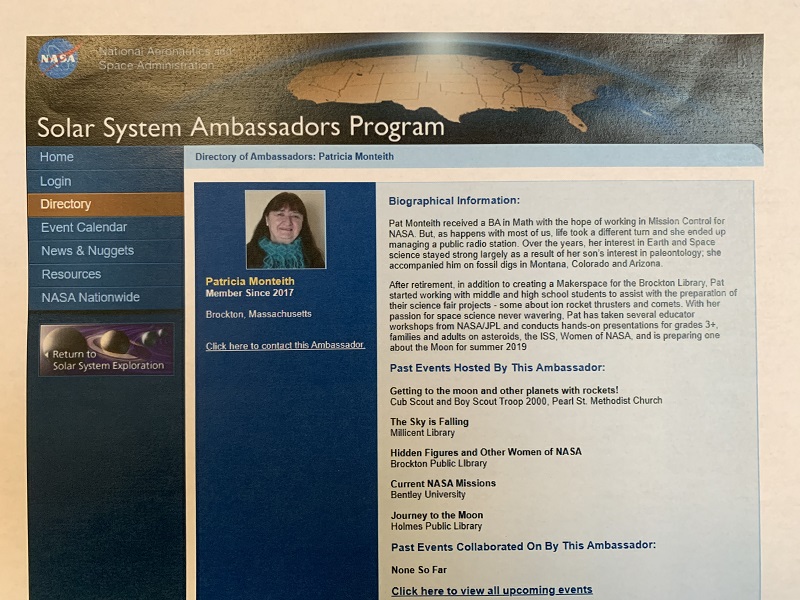
While writing the book, Pat once again ventured into the amazing research available at NASA. She made a decision to bring more about space and the NASA programs to more kids. That required that she fill out an extensive application to become a Solar System Ambassador. She was heartily accepted into the ranks of trained civilians who are willing to go out in their communities to talk space and science.
The commitment is small – just four presentations per year. But, why limit yourself to so few when you can do 40?
It happens that Pat joined this civilian volunteer corps at a great time in NASA history. On August 21, 2017, the amazing solar eclipse occurred. It was the first total solar eclipse visible from coast to coast in 99 years. Then, 2019 ushered in the 50th anniversary of Apollo 11’s moon landing. A thrilling event still for all us Boomers who saw it live.
As an ambassador, Pat creates presentations from the NASA resources and offers them to schools, libraries, and civic groups in her local area. These past few years, she’s been in great demand.

Bringing her love of space to everyone
Pat doesn’t just come with a PowerPoint presentation to her events in schools and libraries. Instead, she walks in dressed head-to-toe in her space jumpsuit and helmet. That dazzles the crowd! They love that she’s an “all-in” presenter and she loves bringing space to kids.
Pat doesn’t limit her knowledge to the kids. She’s also a presenter and advocate of the local senior centers. The Councils on Aging welcome guest speakers. Pat’s presentations about women in the space program or asteroids or adventures in the International Space Station are high-interest, well-attended events. She hosts inter-generational events about space for grandparents and grandkids at the local libraries. Part learning, part hands-on activities, there is something for everybody.
Pat has found that there is tremendous opportunity to offer presentations through adult-education programs at local high schools, and even back at her alma mater, UMass Boston. Pat teaches space in one of the Osher Lifelong Learning Institute (OLLI) offerings there.
No shortage of things to do in retirement
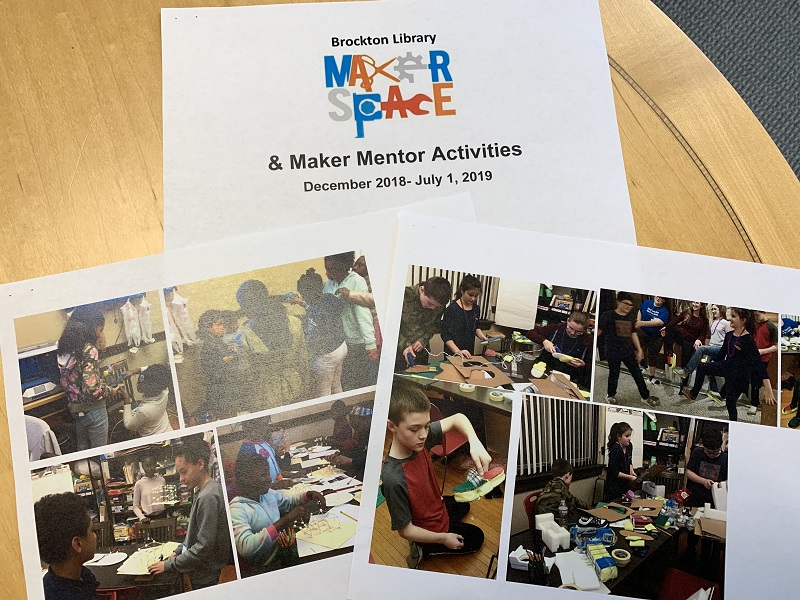
The problem Pat is finding about volunteering in retirement is that there simply isn’t enough time to fit it all in. The opportunities in two areas she loves have ballooned into many new volunteer activities. For example, Pat proposed an idea to teach kids more science and engineering. The result is her creation called the “Maker Space” Program at the Brockton Library:
- Pat develops a year-long curriculum chock-full of all kinds of science and technology experiments. Each week, she sets up hands-on projects for kids to delve deeper into science. Different age groups come different weeks to keep the challenges age-appropriate.
- She helped secure funding to add a 3-D printer to the library and teaches high school kids how to program and create 3-D print files.
- These two programs are so popular that attending is now by invitation only.
Then, there’s Pat’s participation in the Massachusetts’ STEM Week extravaganza. In 2018, the Governor’s office kicked off a state-wide STEM (science, technology, engineering, and math) week program. Pat was on board immediately and helped create an entire day of STEM fun at the Brockton Public library.
- Projects were hands-on for kids of all ages. Everything from “Bugs, bugs, bugs” with a local entomologist to “Build a Birdhouse” with local Home Depot staff members and “Brockton Kids Can Code” where kids learn to program a robot.
- Pat brought in sponsors, local colleges and universities, and businesses and non-profits to talk to older kids about jobs and internships.
- And, not surprisingly, NASA was a key partner in this effort!
And still, there’s more!

As if leading these efforts wasn’t enough, Pat participates in her town’s NAACP organization (National Association for the Advancement of Colored People). One of their key programs is ACT-SO: Afro-Academic, Cultural, Technological and Scientific Olympics. This is a competition for high school kids that includes mentorship and resources for those who want to focus on their academic pursuits and work to achieve more.
There are five areas kids can choose to participate in: Sciences, Humanities, Performing Arts, Visual Arts, and Business. Can you guess where Pat volunteers? In addition to mentoring aspiring scientists, she helps manage the competition event, and spreads the word.
The format is similar to science fairs and the competition is fierce. The students Pat mentors learn a tremendous amount, become more confident in themselves, and tend to be on the winning side of the competition. There are monetary awards for the winning competitors, so this is a big deal.
What can you take away from Pat’s volunteering in retirement approach?
I found Pat to be nothing short of inspirational. She is a down-to-earth, gracious woman who has figured out how to build volunteering in retirement programs. Because she found a whole host of meaningful, interesting, and much-needed areas to focus on in retirement, she does provide some of the answers Boomers are looking for. She’s a great example of the “how-do-I-do-this-volunteering-thing”. She’s found a clear recipe to success:
- Sit at your kitchen table and think about where you’ve been and what you liked best.
- Listen to your kids (or anyone in the younger generation). They often know you best and remember your contributions in ways that are different from your perspective.
- Start with one thing, then build on it. Later, add the next idea and give that a try.
- Explore your local library, not only for ideas, but for the kinds of programming they feel the community can benefit from.
- Never be afraid to ask.
Let me know how you are going to create your own volunteering in retirement programs and contributions. There is more than enough need out there; it’s just a matter of finding what you love and harnessing your expertise in new ways.
Resources
If you’d like to get a jump start on creating your new projects, these resources might be helpful:
This article gives you 9 tips for volunteering in retirement
The Corporation of National and Community Service includes AmeriCorps, Senior Corps, the Volunteer Generation Fund, and more. You might find some good ideas here.
And, you may recall from an earlier blog post, my friend Leslie has tried to retire several times. Take another read to see how work, volunteering, and now book writing are all key ingredients to her Early Retirement: Is the 3rd Time Really a Charm?
